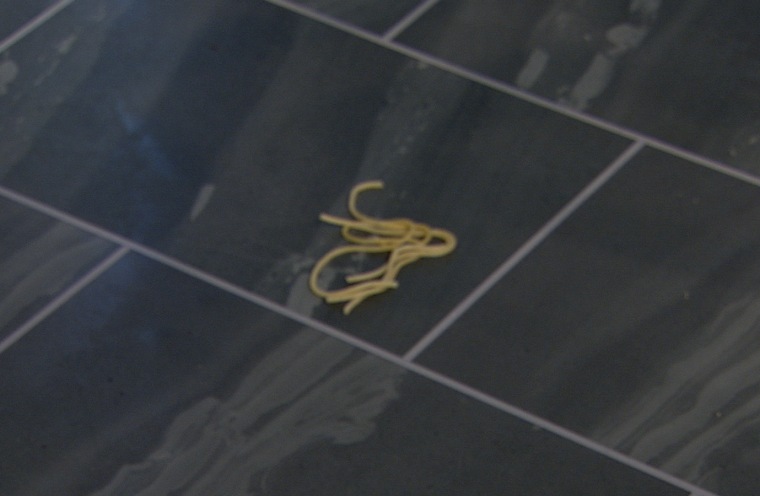Have you ever dropped a piece of food on the floor and instinctively considered the infamous “3-second rule”? This seemingly harmless rule, ingrained in many households, has ignited countless debates amongst friends and family. Is it truly acceptable to eat food that has graced the floor for a mere three seconds, or is it simply a myth perpetuated by our desire to salvage a delicious snack? The 3-second rule, far from being a scientific principle, is a fascinating glimpse into our relationship with food, hygiene, and the sometimes-irrational nature of human behavior.

Image: www.nbcnews.com
Though the concept of a “safe” timeframe for dropped food remains popular, the 3-second rule is not grounded in any scientific evidence. The truth is, food contamination can occur practically instantaneously upon contact with a surface like the floor, regardless of how long it lays there. Bacteria, invisible to the naked eye, can transfer from the floor to food in a fraction of a second, rendering the 3-second rule moot.
Delving Deeper: The Science of Contamination
Food is a prime breeding ground for bacteria. These microscopic organisms are everywhere, from the air we breathe to the surfaces we touch. When food falls to the floor, it encounters a multitude of bacteria, potentially including harmful pathogens such as Salmonella, E. coli, and Listeria. These bacteria can cause food poisoning, leading to uncomfortable symptoms like nausea, diarrhea, vomiting, and abdominal cramps.
The type of floor surface also plays a crucial role. Carpeted floors tend to harbor more bacteria than hard surfaces like tiles or wood due to their ability to trap dust and debris. However, any floor surface can carry bacteria, especially in areas frequented by people and pets, making the 3-second rule irrelevant.
The Role of Time: Does Time Really Matter?
While the concept of a three-second “grace period” is widespread, the truth is that bacteria don’t adhere to a time-based rule. Even a fraction of a second of contact with a contaminated surface can allow bacterial transfer to occur. The 3-second rule is merely a cultural quirk, a way to rationalize our desire to salvage a dropped snack.
A Deeper Dive: Factors Influencing Contamination
Several factors influence the likelihood of food contamination:
- Type of Food: Sticky or moist foods are more susceptible to bacterial growth than dry foods.
- Floor Surface: Carpeted floors tend to harbor more bacteria than hard surfaces, increasing the risk of contamination.
- Hygiene Practices: Frequent cleaning and disinfection of the floor can minimize the risk of bacteria.
- Presence of Pets: Pet fur and waste can introduce bacteria to flooring surfaces.

Image: www.fireupfitness.com
The Bigger Picture: Beyond the 3-Second Rule
While the 3-second rule is often dismissed as a silly superstition, it represents a larger issue: our awareness of hygiene and food safety. The rule, though inaccurate, highlights our inherent desire to minimize waste and save money. However, prioritizing food safety should always outweigh such desires.
Alternatives to the 3-Second Rule:
Instead of relying on a flawed rule, consider these practical tips for maintaining food safety:
- Practice good hygiene: Wash hands thoroughly before preparing and eating food.
- Clean surfaces frequently: Wipe down countertops, kitchen utensils, and floors regularly to prevent bacterial buildup.
- Refrigerate perishable foods promptly: Store food in the refrigerator to prevent bacteria growth.
- Cook food thoroughly: Ensure that meat and poultry reach the appropriate internal temperature to kill harmful bacteria.
- Use separate cutting boards: Utilize different cutting boards for raw meat and vegetables to prevent cross-contamination.
The 3-Second Rule: A Cultural Phenomenon
Beyond its scientific accuracy, the 3-second rule is a fascinating example of cultural norms. It is widely accepted by many people across the globe, demonstrating the power of social influence and shared beliefs. The rule, though scientifically debunked, has become ingrained in our collective consciousness, reminding us of our intricate relationship with food and hygiene.
The 3-second rule also highlights the complex interplay between logic and intuition. While we understand that contamination can occur instantly, the desire to salvage a dropped snack often overpowers our logical understanding. This phenomenon is known as cognitive bias, where our emotions and experiences influence our judgments.
3 Second Rule Food On The Floor
The Bottom Line: Food Safety First!
The 3-second rule, despite its popularity, is a false sense of security. Food can become contaminated instantly upon contact with the floor, regardless of the time spent there. Instead of resorting to a flawed rule, we should prioritize food safety by practicing proper hygiene, cleaning regularly, and employing safe food handling techniques.
Think of the 3-second rule as a reminder of our responsibility to maintain food safety. While the rule itself is flawed, it sparks important conversations about hygiene and the subtle ways we navigate our relationship with food.





